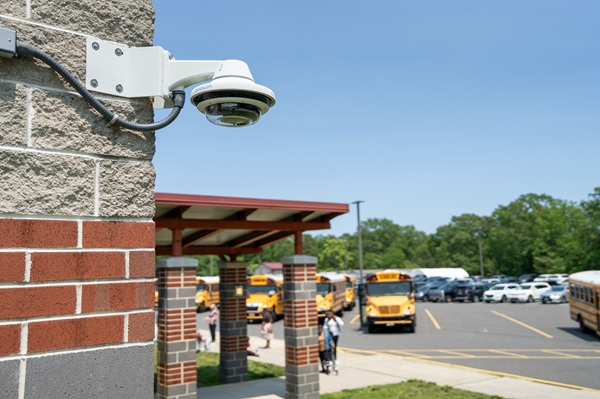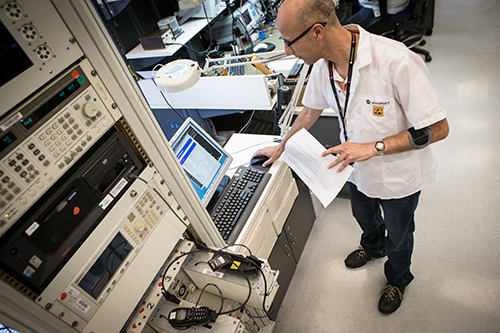1) What is the Rave Panic Button? Who can initiate it and what information does it share with school staff, teachers, School Resource Officers, and first responders?
It is critical for teachers and staff to have the ability to contact help and resources from wherever they are. With a panic button, educational professionals can connect with law enforcement, the fire department, emergency medical services, onsite security personnel, and school administrators to trigger an immediate response.
The Rave Panic Button is a smartphone app, so you always have access to a panic button in your pocket or bag, shaving valuable minutes from response times in an emergency – potentially saving lives. However, the Rave Panic button is more than one big red button on a smartphone screen.
The benefit of having this system in place is that the right service can be provided to the right people as quickly as possible. Onsite security – or onsite medical personnel – can deal with an incident as best they can, or provide an initial response to the incident while awaiting the arrival of police, fire or emergency medical service. Onsite personnel can also remove potential obstacles that may delay the arrival of emergency services once they are alerted to the incident. Rave Panic Button also allows your organization to conduct drills to prepare for all types of emergencies, and manage compliance with reporting by school, date range, and drill type.
2) What does it really mean for a Panic Button to integrate with 9-1-1 and Public Safety?
Navigating an emergency can impact your ability to clearly communicate with responders. Stress, fear, losing connection, or being in a situation where you cannot verbally share critical details can all jeopardize your safety in an emergency.
- Panic Button events appear automatically to 9-1-1 the moment the button is pressed, before the 9-1-1 call is even answered.
- Information like location and the nature of the emergency are automatically displayed at the 9-1-1 workstation.
- Critical facility information including detailed maps of campus and buildings, indoor floorplans, entries/exits, and utility information can also be shared. This aids first responders before arriving on scene to determine next steps and the greatest areas of need.
- Rave Panic Button works for app, landline and mobile activations for a true 9-1-1 integration, allowing 9-1-1 to communicate back when the “All Clear” has been confirmed.
Enhanced 911 (E911), informally referred to as location services for 9-1-1 calling, connects you to the appropriate PSAP that is closest to your location and automatically sends your validated physical location and telephone number to the connected operator. This helps ensure that responders are dispatched to the correct location even if the caller cannot verbally communicate their location with the operator. Basic 9-1-1 calling, on the other hand, requires the distressed caller to tell the 9-1-1 dispatcher their location.
3) Is it in compliance with emerging state mandates such as Alyssa’s Law?
Alyssa’s Law is a legislation, named in remembrance of Alyssa Alhadeff, a victim of the 2018 Marjory Stoneman Douglas High School tragedy, addresses the issue of response time when a life-threatening emergency occurs. The law, already passed in New Jersey and Florida and pending in Texas, calls for the installation of silent panic alarms that are directly linked to first responders so they can get on the scene as quickly as possible, eliminate the threat, and triage any victims. To comply with Alyssa’s Law, Rave Panic Button alert system is already being utilized by dozens of schools in New Jersey and Florida.
4) What happens when the Rave Panic Button is pressed?
This depends on the nature of the incident. In the event of a non-emergency incident, a teacher or other authorized user can alert onsite personnel to an event and the type of assistance required. This is done choosing from a selection of pre-set messages to send to a recipient list. The app can also be used to send custom messages during an incident to provide directions or updates to onsite personnel.
In the event of an emergency, a 9-1-1 call is initiated. The 9-1-1 call dispatcher instantly sees where the call originated, who used the Rave Panic button and what type of emergency service is being requested. The system also enables the 9-1-1 call dispatcher to view details of the facility – such as the best access routes, floor plans of campus buildings and other information such as utility cutoff points. Access to such detailed information contributes to saving time and saving lives.
During the emergency, the Rave Panic Button can be used as an incident management tool. The system allows incident commanders to relay information to first responders and deliver instructions to onsite personnel to better coordinate emergency response. Importantly during an emergency, incident commanders can provide accurate updates to authorized users to combat rumors and suppositions that may be distributed via social media channels.
5) Are users and first responders able to access critical school data like emergency protocols and floor plans?
Emergency response hinges on everyone having the information they need to act. Best practice is to have a panic button solution that allows users—teachers, staff, first responders, and incident commanders, for example—to have quick and easy access to your protocols, school maps, and other critical documents in one application. These documents should be accessible 24/7 on any web-enabled device, including the solution’s mobile app. First responders are able to prepare on their way to the scene and fully understand what they are walking into.
6) Can the panic button solution be customized to your specific needs?
Yes, it can. Emergency activation messages are customizable, including the ability to link to a resource like a fire evacuation route map or active assailant protocols. In addition, non-emergency staff assist templates are customizable so each organization can identify the scenarios (like suspicious objects, unruly students, distressed parents, etc.) in which they want to use the system. Notification groups are customizable, so that all staff are notified of assailant incidents, but only admins and nursing staff are notified about medical incidents. An in-app content repository can be populated with each campus’ emergency documents, floorplans, evacuation routes, and more.
7) How can you best prepare for successful use of the Rave Panic Button?
Providing authorized users with access to the Rave Panic Button is an excellent first step toward safety. However, in order to achieve the most effective use of the system, the mechanisms need to be in place for 9-1-1 call responders to view details of the facility. To maximize safety, authorized users need to understand the procedures to follow during an emergency or non-emergency incident.
School officials can upload the relevant information via the web-based Rave Panic Button dashboard – which also serves as a useful incident management tool during an emergency. However, to better prepare onsite security and medical personnel for an emergency or non-emergency incident, school officials need to compile an emergency button activation plan. The plan should include school safety drills in which authorized users and 9-1-1 call dispatchers get practical experience of using the system under trial conditions. These drills can be life-saving, as they prepare members of your organization for unpredictable emergencies.
As different facilities have different designs, it can be advantageous to see the system in action before compiling an emergency button activation plan. In this respect, we invite school officials to contact us and arrange a free demonstration of the Rave Panic Button in order to better understand its capabilities. The demonstration will also provide an opportunity for onsite security and medical personnel to ask questions about how the Rave Panic Button works in specific circumstances. More than 10,000 schools and organizations across the U.S. trust the Rave Panic Button to enhance collaboration with 9-1-1, first responders and authorized personnel for emergency planning and panic button drills.





Comments are closed here.